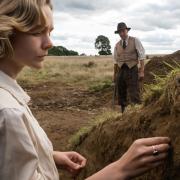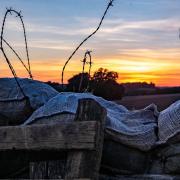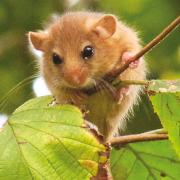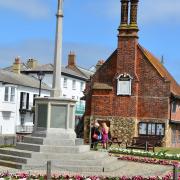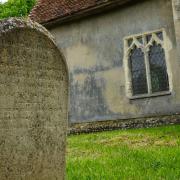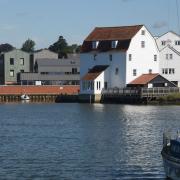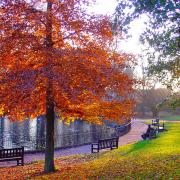David Falk, manager of Suffolk County Council’s Brandon Country Park, heads to the heart of Suffolk and the family-friendly Thornham Walks with its miles of footpaths, imaginative fun sculptures, historic hall and ancient oaks
There’s something very exotic about the sound of a peacock. It cuts through the air. It transports me to a faraway land. Here in the very heart of Suffolk, in a quintessential pastoral setting, it seems both out of place yet very much part of the landscape.
There used to be quite a few peacocks, plus a small collection of pheasants, at Thornham Estate. I’m not sure where they all are now. The exotic collection of pheasants seems long gone, but a solitary male peacock is certainly still resident and he lets the world know his presence.
He stands atop a small mound, his brilliant blue chest puffed out proud, small crown erect. He stares about, a stranger in a foreign land. Around him lies a field of freshly cut hay. A pair of greater spotted woodpeckers fly from tree to tree. A family of mistle thrushes hop about. Rooks peck at the ground. A lawnmower drones in the background.
I’m standing beside my car, binoculars in hand, in a simple car park overlooked by a grand old oak surrounded by a wooden sculpture-filled playground. It’s full of imagination – giant squirrels, intertwined snakes, insects and a bear rubbing its ear. There’s a sense of humour here.

I grab a site map from a simple information board and head along a solid path into the estate. Thornham Walks made the news recently due to the addition of compost loos. These waterless green latrines are very impressive – spotless and smell-free. They’re a clever addition to the site and helpfully open today when everything else is closed.
The path winds onwards between fields of Limousin cattle, small thickets of oak, rowan and lime, to a platform overlooking Spinney Pond. This is one of 36 farm ponds dotted around the estate, once watering holes for cattle. Today, Spinney Pond is a small wildlife haven, its waters a dark soup of plant life, the air above a blur of midges.
Walking on I enter a line of walnut and cherry trees. Behind, sits a carved throne. Cut from the trunk of an oak tree, it’s another of the many sculptures dotted around the Thornham Estate. Each provides a fun stop – climbing frames for all ages, photo opportunities for families.
Hidden behind 600-year-old ancient oaks, I catch a glimpse of Thornham Hall.
It was re-built in 1956 after a chequered history. The original Tudor Hall was Victorianised, then modernised, then requisitioned by the army and then, in 1954, it burned to the ground. What’s there today is all but concealed by the landscape.
The path leads onto a mown strip of grass that winds through a pinetum – a collection of cypresses, pines, junipers, spruce and firs. Beneath the trees grass has grown tall. It’s full of thistles, buttercups and crowds of common spotted orchids. They stand upright, heads of tiny purple flowers on strong green stems that emerge from pointed, brown speckled leaves. I sit on a bench to soak up the scene and listen to the “chiff chaff” of a Chiffchaff. It sings forever like a pulsating stuck record.
Along a short stretch of boardwalk lies a bird hide. Inside a family are peering onto a woodland scene. Phone cameras in hand, they try to capture a squirrel feeding on bird feeders. Children whisper excitement to grandparents, who whisper frustration on hitting the wrong buttons as the squirrel rushes in and out of the scene.
Back on the path, I pass a carved lion. Its mane a bark-covered trunk, its body carved from smooth wood with short lengths of logs for its legs. Past ancient yews and giant oaks, I stop at a towering grand fir. A small branch has fallen to the ground and I take the chance to crush its needles to release the scent of tangerine. It’s one of my favourite nature experiences. A Cedar of Lebanon extends its limbs like an early morning stretch and bronze coloured paper birch decorate the path.
The air is full of scent as I walk past a series of raised beds, containing fragrant herbs. Divided by a line of topiary they sit in front of Thornham Estate’s Walled Garden. Back in the 1800s, nine gardeners worked here. Today it’s home to Beyond the Wall, a charity providing work experience to young people. I sneak a look through the bars of a locked red gate and see lines of squat fruit trees, clipped boxes, and a long glasshouse where they once grew melons.

The Walled Garden’s faded red brick wall hides the garden from view, but I pace around the perimeter, past another set of green latrines, to a restored folly. Built from an assortment of reclaimed stones, this was once a gothic summerhouse and a resting place on countryside strolls. Today it stands guard over the Pet Cemetery, the resting place of treasured family pets including Mahuta, who served in the Egyptian Campaign, Toto, killed in Pretoria, and Dracula, a black Alsatian born in Jakarta.
Looping back on myself, I retrace steps past the bird hide, through the pinetum and beyond Spinneys Pond to the play area and car park. I look again across fields of hay and see a pheasant tiptoeing through grass, pigeons flapping about and the family of mistle thrushes still hopping.
As I depart I leave behind grandchildren playing with grandparents, toddlers sleeping in pushchairs, mothers piggybacking kids, and summertime laughter blending with the exotic calls of the ever-present peacock.
Thornham Estate Info
Location: 16, Red House Yard, Gislingham Rd, Eye IP23 8HH
Opening Times: 9 am - 6 pm from April to October and 9 am - 4 pm from November to March
Dog Friendly: Dogs are welcome but must be kept on leads at all times
Car Park: £2.00 all day on weekdays and £3.00 all day on weekends and bank holidays
Refreshments: The Forge Tea Rooms and The Coach House is coming soon.
Find out more information about the Thornham Estate here: www.thornhamestate.com




